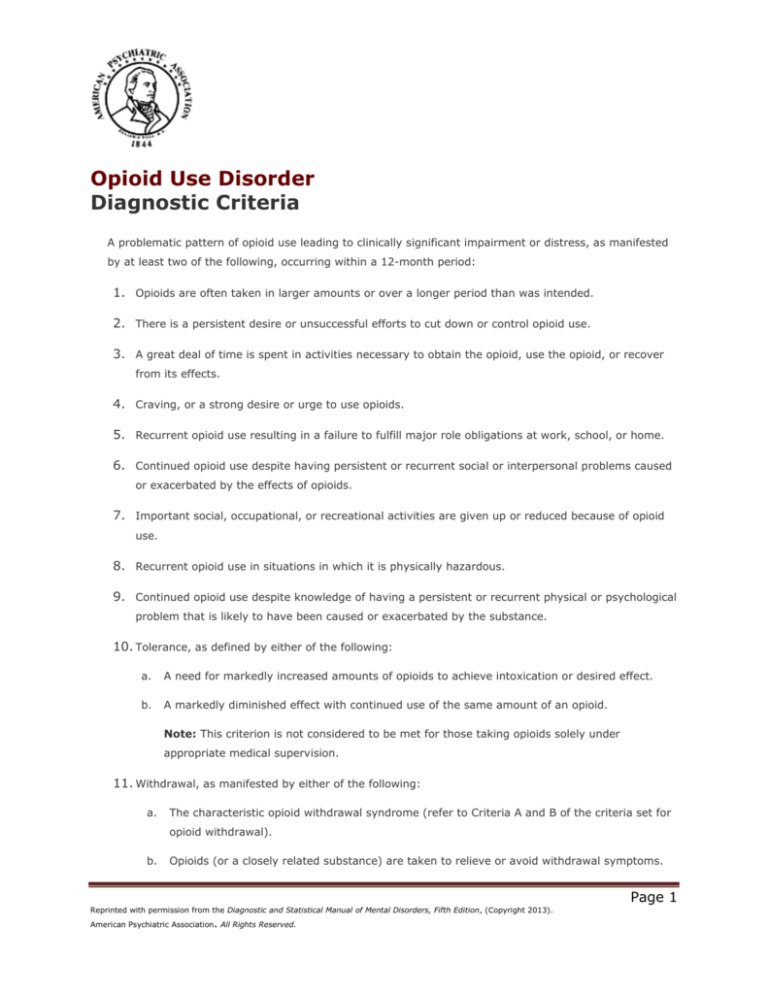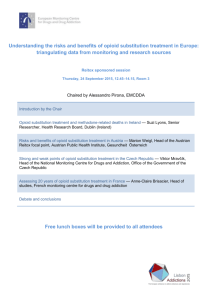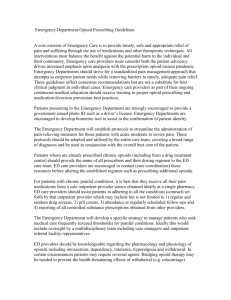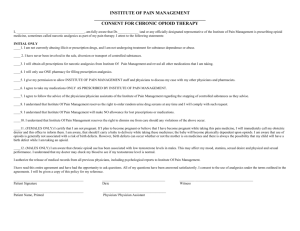
Opioid Use Disorder
Diagnostic Criteria
A problematic pattern of opioid use leading to clinically significant impairment or distress, as manifested
by at least two of the following, occurring within a 12-month period:
1. Opioids are often taken in larger amounts or over a longer period than was intended.
2. There is a persistent desire or unsuccessful efforts to cut down or control opioid use.
3. A great deal of time is spent in activities necessary to obtain the opioid, use the opioid, or recover
from its effects.
4. Craving, or a strong desire or urge to use opioids.
5. Recurrent opioid use resulting in a failure to fulfill major role obligations at work, school, or home.
6. Continued opioid use despite having persistent or recurrent social or interpersonal problems caused
or exacerbated by the effects of opioids.
7. Important social, occupational, or recreational activities are given up or reduced because of opioid
use.
8. Recurrent opioid use in situations in which it is physically hazardous.
9. Continued opioid use despite knowledge of having a persistent or recurrent physical or psychological
problem that is likely to have been caused or exacerbated by the substance.
10. Tolerance, as defined by either of the following:
a.
A need for markedly increased amounts of opioids to achieve intoxication or desired effect.
b.
A markedly diminished effect with continued use of the same amount of an opioid.
Note: This criterion is not considered to be met for those taking opioids solely under
appropriate medical supervision.
11. Withdrawal, as manifested by either of the following:
a.
The characteristic opioid withdrawal syndrome (refer to Criteria A and B of the criteria set for
opioid withdrawal).
b.
Opioids (or a closely related substance) are taken to relieve or avoid withdrawal symptoms.
Page 1
Reprinted with permission from the Diagnostic and Statistical Manual of Mental Disorders, Fifth Edition, (Copyright 2013).
.
American Psychiatric Association All Rights Reserved.
Note: This criterion is not considered to be met for those individuals taking opioids solely
under appropriate medical supervision.
Specify if:
In early remission: After full criteria for opioid use disorder were previously met, none of
the criteria for opioid use disorder have been met for at least 3 months but for less than 12
months (with the exception that Criterion A4, “Craving, or a strong desire or urge to use
opioids,” may be met).
In sustained remission: After full criteria for opioid use disorder were previously met, none
of the criteria for opioid use disorder have been met at any time during a period of 12
months or longer (with the exception that Criterion A4, “Craving, or a strong desire or urge
to use opioids,” may be met).
Specify if:
On maintenance therapy: This additional specifier is used if the individual is taking a
prescribed agonist medication such as methadone or buprenorphine and none of the criteria
for opioid use disorder have been met for that class of medication (except tolerance to, or
withdrawal from, the agonist). This category also applies to those individuals being
maintained on a partial agonist, an agonist/antagonist, or a full antagonist such as oral
naltrexone or depot naltrexone.
In a controlled environment: This additional specifier is used if the individual is in an
environment where access to opioids is restricted.
Coding based on current severity: Note for ICD-10-CM codes: If an opioid intoxication, opioid
withdrawal, or another opioid-induced mental disorder is also present, do not use the codes below for opioid
use disorder. Instead, the comorbid opioid use disorder is indicated in the 4th character of the opioidinduced disorder code (see the coding note for opioid intoxication, opioid withdrawal, or a specific opioidinduced mental disorder). For example, if there is comorbid opioid-induced depressive disorder and opioid
use disorder, only the opioid-induced depressive disorder code is given, with the 4th character indicating
whether the comorbid opioid use disorder is mild, moderate, or severe: F11.14 for mild opioid use disorder
with opioid-induced depressive disorder or F11.24 for a moderate or severe opioid use disorder with opioidinduced depressive disorder.
Specify current severity:
305.50 (F11.10) Mild: Presence of 2–3 symptoms.
304.00 (F11.20) Moderate: Presence of 4–5 symptoms.
Page 2
Reprinted with permission from the Diagnostic and Statistical Manual of Mental Disorders, Fifth Edition, (Copyright 2013).
.
American Psychiatric Association All Rights Reserved.
304.00 (F11.20) Severe: Presence of 6 or more symptoms.
Specifiers
The “on maintenance therapy” specifier applies as a further specifier of remission if the individual is both in
remission and receiving maintenance therapy. “In a controlled environment” applies as a further specifier of
remission if the individual is both in remission and in a controlled environment (i.e., in early remission in a
controlled environment or in sustained remission in a controlled environment). Examples of these
environments are closely supervised and substance-free jails, therapeutic communities, and locked hospital
units.
Changing severity across time in an individual is also reflected by reductions in the frequency (e.g., days of
use per month) and/or dose (e.g., injections or number of pills) of an opioid, as assessed by the individual’s
self-report, report of knowledgeable others, clinician’s observations, and biological testing.
Diagnostic Features
Opioid use disorder includes signs and symptoms that reflect compulsive, prolonged self-administration of
opioid substances that are used for no legitimate medical purpose or, if another medical condition is present
that requires opioid treatment, that are used in doses greatly in excess of the amount needed for that
medical condition. (For example, an individual prescribed analgesic opioids for pain relief at adequate dosing
will use significantly more than prescribed and not only because of persistent pain.) Individuals with opioid
use disorder tend to develop such regular patterns of compulsive drug use that daily activities are planned
around obtaining and administering opioids. Opioids are usually purchased on the illegal market but may
also be obtained from physicians by falsifying or exaggerating general medical problems or by receiving
simultaneous prescriptions from several physicians. Health care professionals with opioid use disorder will
often obtain opioids by writing prescriptions for themselves or by diverting opioids that have been prescribed
for patients or from pharmacy supplies. Most individuals with opioid use disorder have significant levels of
tolerance and will experience withdrawal on abrupt discontinuation of opioid substances. Individuals with
opioid use disorder often develop conditioned responses to drug-related stimuli (e.g., craving on seeing any
heroin powder–like substance)—a phenomenon that occurs with most drugs that cause intense psychological
changes. These responses probably contribute to relapse, are difficult to extinguish, and typically persist
long after detoxification is completed (Fatseas et al. 2011b).
Associated Features Supporting Diagnosis
Opioid use disorder can be associated with a history of drug-related crimes (e.g., possession or distribution
of drugs, forgery, burglary, robbery, larceny, receiving stolen goods). Among health care professionals and
individuals who have ready access to controlled substances, there is often a different pattern of illegal
activities involving problems with state licensing boards, professional staffs of hospitals, or other
Page 3
Reprinted with permission from the Diagnostic and Statistical Manual of Mental Disorders, Fifth Edition, (Copyright 2013).
.
American Psychiatric Association All Rights Reserved.
administrative agencies. Marital difficulties (including divorce), unemployment, and irregular employment
are often associated with opioid use disorder at all socioeconomic levels.
Prevalence
The 12-month prevalence of opioid use disorder is approximately 0.37% among adults age 18 years and
older in the community population (Compton et al. 2007). This may be an underestimate because of the
large number of incarcerated individuals with opioid use disorders (Compton et al. 2010). Rates are higher
in males than in females (0.49% vs. 0.26%), with the male-to-female ratio typically being 1.5:1 for opioids
other than heroin (i.e., available by prescription) and 3:1 for heroin. Female adolescents may have a higher
likelihood of developing opioid use disorders (Wu et al. 2009). The prevalence decreases with age, with the
prevalence highest (0.82%) among adults age 29 years or younger, and decreasing to 0.09% among adults
age 65 years and older. Among adults, the prevalence of opioid use disorder is lower among African
Americans at 0.18% and overrepresented among Native Americans at 1.25%. It is close to average among
whites (0.38%), Asian or Pacific Islanders (0.35%), and Hispanics (0.39%) (Wu et al. 2009).
Among individuals in the United States ages 12–17 years, the overall 12-month prevalence of opioid use
disorder in the community population is approximately 1.0%, but the prevalence of heroin use disorder is
less than 0.1%. By contrast, analgesic use disorder is prevalent in about 1.0% of those ages 12–17 years,
speaking to the importance of opioid analgesics as a group of substances with significant health
consequences (Substance Abuse and Mental Health Services Administration 2011).
The 12-month prevalence of problem opioid use in European countries in the community population ages
15–64 years is between 0.1% and 0.8%. The average prevalence of problem opioid use in the European
Union and Norway is between 0.36% and 0.44% (European Monitoring Centre for Drugs and Drug Addiction
2010).
Development and Course
Opioid use disorder can begin at any age, but problems associated with opioid use are most commonly first
observed in the late teens or early 20s. Once opioid use disorder develops, it usually continues over a period
of many years, even though brief periods of abstinence are frequent. In treated populations, relapse
following abstinence is common. Even though relapses do occur, and while some long-term mortality rates
may be as high as 2% per year, about 20%–30% of individuals with opioid use disorder achieve long-term
abstinence. An exception concerns that of military service personnel who became dependent on opioids in
Vietnam; over 90% of this population who had been dependent on opioids during deployment in Vietnam
achieved abstinence after they returned, but they experienced increased rates of alcohol or amphetamine
use disorder as well as increased suicidality (Price et al. 2001).
Page 4
Reprinted with permission from the Diagnostic and Statistical Manual of Mental Disorders, Fifth Edition, (Copyright 2013).
.
American Psychiatric Association All Rights Reserved.
Increasing age is associated with a decrease in prevalence as a result of early mortality and the remission of
symptoms after age 40 years (i.e., “maturing out”). However, many individuals continue have presentations
that meet opioid use disorder criteria for decades (Hser et al. 2007).
Risk and Prognostic Factors
Genetic and physiological
The risk for opiate use disorder can be related to individual, family, peer, and social environmental factors
(Kendler et al. 2003; Tsuang et al. 1998), but within these domains, genetic factors play a particularly
important role both directly and indirectly. For instance, impulsivity and novelty seeking are individual
temperaments that relate to the propensity to develop a substance use disorder but may themselves be
genetically determined. Peer factors may relate to genetic predisposition in terms of how an individual
selects his or her environment.
Culture-Related Diagnostic Issues
Despite small variations regarding individual criterion items, opioid use disorder diagnostic criteria perform
equally well across most race/ethnicity groups. Individuals from ethnic minority populations living in
economically deprived areas have been overrepresented among individuals with opioid use disorder.
However, over time, opioid use disorder is seen more often among white middle-class individuals, especially
females, suggesting that differences in use reflect the availability of opioid drugs and that other social
factors may impact prevalence. Medical personnel who have ready access to opioids may be at increased
risk for opioid use disorder.
Diagnostic Markers
Routine urine toxicology test results are often positive for opioid drugs in individuals with opioid use
disorder. Urine test results remain positive for most opioids (e.g., heroin, morphine, codeine, oxycodone,
propoxyphene) for 12–36 hours after administration. Fentanyl is not detected by standard urine tests but
can be identified by more specialized procedures for several days. Methadone, buprenorphine (or
buprenorphine/naloxone combination), and LAAM (L-alpha-acetylmethadol) have to be specifically tested for
and will not cause a positive result on routine tests for opiates. They can be detected for several days up to
more than 1 week. Laboratory evidence of the presence of other substances (e.g., cocaine, marijuana,
alcohol, amphetamines, benzodiazepines) is common. Screening test results for hepatitis A, B, and C virus
are positive in as many as 80%–90% of injection opioid users, either for hepatitis antigen (signifying active
infection) or for hepatitis antibody (signifying past infection). HIV is prevalent in injection opioid users as
well. Mildly elevated liver function test results are common, either as a result of resolving hepatitis or from
toxic injury to the liver due to contaminants that have been mixed with the injected opioid. Subtle changes
Page 5
Reprinted with permission from the Diagnostic and Statistical Manual of Mental Disorders, Fifth Edition, (Copyright 2013).
.
American Psychiatric Association All Rights Reserved.
in cortisol secretion patterns and body temperature regulation have been observed for up to 6 months
following opioid detoxification.
Suicide Risk
Similar to the risk generally observed for all substance use disorders, opioid use disorder is associated with a
heightened risk for suicide attempts and completed suicides. Particularly notable are both accidental and
deliberate opioid overdoses. Some suicide risk factors overlap with risk factors for an opioid use disorder. In
addition, repeated opioid intoxication or withdrawal may be associated with severe depressions that,
although temporary, can be intense enough to lead to suicide attempts and completed suicides. Available
data suggest that nonfatal accidental opioid overdose (which is common) and attempted suicide are distinct
clinically significant problems that should not be mistaken for each other.
Functional Consequences of Opioid Use Disorder
Opioid use is associated with a lack of mucous membrane secretions, causing dry mouth and nose. Slowing
of gastrointestinal activity and a decrease in gut motility can produce severe constipation. Visual acuity may
be impaired as a result of pupillary constriction with acute administration. In individuals who inject opioids,
sclerosed veins (“tracks”) and puncture marks on the lower portions of the upper extremities are common.
Veins sometimes become so severely sclerosed that peripheral edema develops, and individuals switch to
injecting in veins in the legs, neck, or groin. When these veins become unusable, individuals often inject
directly into their subcutaneous tissue (“skin-popping”), resulting in cellulitis, abscesses, and circularappearing scars from healed skin lesions. Tetanus and Clostridium botulinum infections are relatively rare
but extremely serious consequences of injecting opioids, especially with contaminated needles. Infections
may also occur in other organs and include bacterial endocarditis, hepatitis, and HIV infection. Hepatitis C
infections, for example, may occur in up to 90% of persons who inject opioids. In addition, the prevalence of
HIV infection can be high among individuals who inject drugs, a large proportion of whom are individuals
with opioid use disorder. HIV infection rates have been reported to be as high as 60% among heroin users
with opioid use disorder in some areas of the United States or the Russian Federation. However, the
incidence may also be 10% or less in other areas, especially those where access to clean injection material
and paraphernalia is facilitated (Fatseas et al. 2011a).
Tuberculosis is a particularly serious problem among individuals who use drugs intravenously, especially
those who are dependent on heroin; infection is usually asymptomatic and evident only by the presence of a
positive tuberculin skin test. However, many cases of active tuberculosis have been found, especially among
those who are infected with HIV. These individuals often have a newly acquired infection but also are likely
to experience reactivation of a prior infection because of impaired immune function.
Individuals who sniff heroin or other opioids into the nose (“snorting”) often develop irritation of the nasal
mucosa, sometimes accompanied by perforation of the nasal septum. Difficulties in sexual functioning are
Page 6
Reprinted with permission from the Diagnostic and Statistical Manual of Mental Disorders, Fifth Edition, (Copyright 2013).
.
American Psychiatric Association All Rights Reserved.
common. Males often experience erectile dysfunction during intoxication or chronic use. Females commonly
have disturbances of reproductive function and irregular menses.
In relation to infections such as cellulitis, hepatitis, HIV infection, tuberculosis, and endocarditis, opioid use
disorder is associated with a mortality rate as high as 1.5%–2% per year. Death most often results from
overdose, accidents, injuries, AIDS, or other general medical complications. Accidents and injuries due to
violence that is associated with buying or selling drugs are common. In some areas, violence accounts for
more opioid-related deaths than overdose or HIV infection. Physiological dependence on opioids may occur
in about half of the infants born to females with opioid use disorder; this can produce a severe withdrawal
syndrome requiring medical treatment. Although low birth weight is also seen in children of mothers with
opioid use disorder, it is usually not marked and is generally not associated with serious adverse
consequences.
Differential Diagnosis
Opioid-induced mental disorders
Opioid-induced disorders occur frequently in individuals with opioid use disorder. Opioid-induced disorders
may be characterized by symptoms (e.g., depressed mood) that resemble primary mental disorders (e.g.,
persistent depressive disorder [dysthymia] vs. opioid-induced depressive disorder, with depressive features,
with onset during intoxication). Opioids are less likely to produce symptoms of mental disturbance than are
most other drugs of abuse. Opioid intoxication and opioid withdrawal are distinguished from the other
opioid-induced disorders (e.g., opioid-induced depressive disorder, with onset during intoxication) because
the symptoms in these latter disorders predominate the clinical presentation and are severe enough to
warrant independent clinical attention.
Other substance intoxication
Alcohol intoxication and sedative, hypnotic, or anxiolytic intoxication can cause a clinical picture that
resembles that for opioid intoxication. A diagnosis of alcohol or sedative, hypnotic, or anxiolytic intoxication
can usually be made based on the absence of pupillary constriction or the lack of a response to naloxone
challenge. In some cases, intoxication may be due both to opioids and to alcohol or other sedatives. In
these cases, the naloxone challenge will not reverse all of the sedative effects.
Other withdrawal disorders
The anxiety and restlessness associated with opioid withdrawal resemble symptoms seen in sedativehypnotic withdrawal. However, opioid withdrawal is also accompanied by rhinorrhea, lacrimation, and
pupillary dilation, which are not seen in sedative-type withdrawal. Dilated pupils are also seen in
hallucinogen intoxication and stimulant intoxication. However, other signs or symptoms of opioid withdrawal,
such as nausea, vomiting, diarrhea, abdominal cramps, rhinorrhea, or lacrimation, are not present.
Page 7
Reprinted with permission from the Diagnostic and Statistical Manual of Mental Disorders, Fifth Edition, (Copyright 2013).
.
American Psychiatric Association All Rights Reserved.
Comorbidity
The most common medical conditions associated with opioid use disorder are viral (e.g., HIV, hepatitis C
virus) and bacterial infections, particularly among users of opioids by injection. These infections are less
common in opioid use disorder with prescription opioids. Opioid use disorder is often associated with other
substance use disorders, especially those involving tobacco, alcohol, cannabis, stimulants, and
benzodiazepines, which are often taken to reduce symptoms of opioid withdrawal or craving for opioids, or
to enhance the effects of administered opioids. Individuals with opioid use disorder are at risk for the
development of mild to moderate depression that meets symptomatic and duration criteria for persistent
depressive disorder (dysthymia) or, in some cases, for major depressive disorder (Compton et al. 2005).
These symptoms may represent an opioid-induced depressive disorder or an exacerbation of a preexisting
primary depressive disorder. Periods of depression are especially common during chronic intoxication or in
association with physical or psychosocial stressors that are related to the opioid use disorder. Insomnia is
common, especially during withdrawal. Antisocial personality disorder is much more common in individuals
with opioid use disorder than in the general population (Compton et al. 2005). Posttraumatic stress disorder
is also seen with increased frequency (Price et al. 2004). A history of conduct disorder in childhood or
adolescence has been identified as a significant risk factor for substance-related disorders, especially opioid
use disorder.
References: Opioid Use Disorder
Compton WM, Conway KP, Stinson FS, et al: Prevalence, correlates, and comorbidity of DSM-IV antisocial
personality syndromes and alcohol and specific substance use disorders in the United States: results from
the national epidemiologic survey on alcohol and related conditions. J Clin Psychiatry 66(6):677–685, 2005
[PubMed]
Compton WM, Thomas YF, Stinson FS, Grant BF: Prevalence, correlates, disability, and comorbidity of DSMIV drug abuse and dependence in the United States: results from the national epidemiologic survey on
alcohol and related conditions. Arch Gen Psychiatry 64(5):566–576, 2007
[PubMed]
Compton WM, Dawson D, Duffy SQ, Grant BF: The effect of inmate populations on estimates of DSM-IV
alcohol and drug use disorders in the United States. Am J Psychiatry 167(4):473–475, 2010
[PubMed]
Conway KP, Compton WM, Stinson FS, Grant BF: Lifetime comorbidity of DSM-IV mood and anxiety
disorders and specific drug use disorders: results from the National Epidemiologic Survey on Alcohol and
Related Conditions. J Clin Psychiatry 67(2):247–257, 2006
[PubMed]
European Monitoring Centre for Drugs and Drug Addiction: Opioid use and drug injection, in Annual Report
2010: The States of the Drugs Problem in Europe. Lisbon, European Monitoring Centre for Drugs and Drug
Page 8
Reprinted with permission from the Diagnostic and Statistical Manual of Mental Disorders, Fifth Edition, (Copyright 2013).
.
American Psychiatric Association All Rights Reserved.
Addiction, November 2010. Available at: http://www.emcdda.europa.eu/online/annualreport/2010/opioids. Accessed April 15, 2012.
Fatseas M, Denis C, Massida Z, et al: Cue-induced reactivity, cortisol response and substance use outcome
in treated heroin dependent individuals. Biol Psychiatry 70(8):720–727, 2011a
[PubMed]
Fatseas M, Denis C, Serre F, et al: Change in HIV-HCV risk-taking behavior and seroprevalence among
opiate users seeking treatment over an 11-year period and harm reduction policy. AIDS Behav 16(7):2082–
2090, 2011b
[PubMed]
Hser YI, Huang D, Chou CP, Anglin MD: Trajectories of heroin addiction: growth mixture modeling results
based on a 33-year follow-up study. Eval Rev 31(6):548–563, 2007
[PubMed]
Kendler KS, Jacobson KC, Prescott CA, Neale MC: Specificity of genetic and environmental risk factors for
use and abuse/dependence of cannabis, cocaine, hallucinogens, sedatives, stimulants, and opiates in male
twins. Am J Psychiatry 160(4):687–695, 2003
[PubMed]
Price RK, Risk NK, Spitznagel EL: Remission from drug abuse over a 25-year period: patterns of remission
and treatment use. Am J Public Health 91(7):1107–1113, 2001
[PubMed]
Price RK, Risk NK, Haden AH, et al: Post-traumatic stress disorder, drug dependence, and suicidality among
male Vietnam veterans with a history of heavy drug use. Drug Alcohol Depend 76(suppl):S31–43, 2004
[PubMed]
Substance Abuse and Mental Health Services Administration, Center for Behavioral Health Statistics and
Quality: 2010 National Survey on Drug Use and Health:Table 5.2B Substance dependence or abuse for
specific substances in the past year, by age group: percentages 2009–2010. Rockville, MD, Substance Abuse
and Mental Health Services Administration, 2011. Available at:
http:oas.samhsa.gov/nsduh/2K10NSDUH/tabs/Sect5peTabs1to56.htm#tab5.2B. Accessed June
15, 2012.
Tsuang MT, Lyons MJ, Meyer JM, et al: Co-occurrence of abuse of different drugs in men: the role of drugspecific and shared vulnerabilities. Arch Gen Psychiatry 55(11):967–972, 1998
[PubMed]
Wu LT, Pan JJ, Blazer DG, et al: The construct and measurement equivalence of cocaine and opioid
dependences: a National Drug Abuse Treatment Clinical Trials Network (CTN) study. Drug Alcohol Depend
103(3):114–123, 2009
[PubMed]
Page 9
Reprinted with permission from the Diagnostic and Statistical Manual of Mental Disorders, Fifth Edition, (Copyright 2013).
.
American Psychiatric Association All Rights Reserved.






